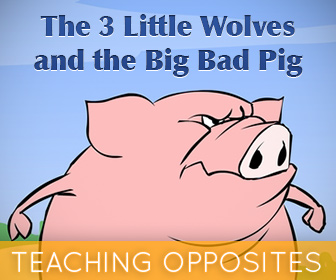What would you do if a big, bad pig tried to blow down your little brick house?
Run away as the bricks tumbled, just like the three little wolves did in Eugene Trivizas’ story The Three Little Wolves and the Big Bad Pig. As strange and as entertaining as it sounds, this book might be just what you need to liven class up the next time you teach opposites! Here’s how you can use it in your ESL class.

How to Teach Opposites
-
1
The Three Little Pigs
Do your students know the story of the three little pigs? As a class, allow students to share anything they already know about the story and retell it if they already know it. If no one knows the story already, ask them what they think might happen based on the title. Once your students have offered some ideas, read the story to them. Ask your students to notice any words that describe the pigs and the wolf as you read. After you finish the story, work with your class to make a list of these descriptive words on the board.
-
2
Retelling
To make sure your students have the story clearly in their minds, ask your students to retell the story in their own words. If your students would like, allow them to illustrate their stories. You might want to let students type up their retellings and illustrate them on the computer. You can print them out and display them on a wall of your classroom.
-
3
Antonyms
Next, explain to your class that you are going to talk about antonyms or opposites. Give them several examples of antonym pairs. Take one pair, big and little for example, and write them on opposite ends of the board. Now draw a symbol at each end, one big and one little. Show your students that antonyms are words at opposite ends of a spectrum. Draw several of the same symbol along the spectrum getting increasingly big or little. Point out to your students that the antonyms are the words farthest from one another. As a class, brainstorm as many antonym pairs as you can think of. When you are finished, you may want to have your students illustrate one or more of the other antonym pairs you listed on their own spectrums.
-
4
The Big, Bad Pig
Now that your students know the traditional tale and are familiar with antonyms, it is time for the fractured version. Read Trivizas’ The Three Little Wolves and the Big Bad Pig to your class. Ask them to listen for two things as you read. First, challenge them to note any differences between this story and the original version. Second, ask them to note any descriptive words used for the wolves and the pig.
-
5
Compare and Contrast
Explain to your students that a Venn diagram is a way to look at the similarities and differences between two things. Show your students how to create a Venn diagram by drawing two overlapping circles on the board. Label one circle “3 little pigs” and the other “3 little wolves”. Ask your students to write the similarities between the two stories in the overlapping section. Then ask them to write the parts unique to each story in its circle.
-
6
What Opposites Can You Find?
Looking at the lists of descriptive words, can your students find any opposite pairs among them? Give groups of two to three students some time to work together to find opposites in and between the two stories. You will want to have copies of each text for each group of students. If students are unable to find a pair of opposites for the descriptive words within the text, ask them to think of word that would be the opposite to the ones that were used.
-
7
Opposites Perform
Now that your students have seen and worked with the opposite version of the three little pigs, challenge your students to write their own fractured fairytales! Supply groups of three to five students with some traditional children’s tales. Ask each group to choose one traditional tale and to plan a skit that tells an opposite story. They should write their skit as they prepare. Reassure them that not every element in their skits will be opposite of the original, just as Trivizas’ version of the three little pigs was not a complete opposite. Each skit should, however, have at least one major opposite from its original version. After the groups have planned their skits, have them perform for the rest of the class.
Play day may be a good occasion to have opposite day in your class and celebrate the idea of antonyms.
Do your classes in reverse order! Face your desks to the opposite wall! Read a book from the last page forward or do any of a number of opposite things! Your kids will have fun and they will really understand the concept of opposites!
P.S. If you enjoyed this article, please help spread it by clicking one of those sharing buttons below. And if you are interested in more, you should follow our Facebook page where we share more about creative, non-boring ways to teach English.







